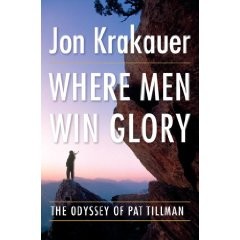Which is more important, American readers: the story of fictional Harvard symbologist Robert Langdon or the story of real American soldier Pat Tillman?
The answer seems obvious: the story of American hero and friendly fire casualty Pat Tillman is of more moral, political and humanistic importance than Langdon’s latest sexy, silly conspiracy-busting romp.
Yet, while Dan Brown’s latest book “”The Lost Symbol”” has shattered all adult sales records and now has over 5.5 million copies in print, Jon Krakauer’s biography of Pat Tillman, “”Where Men Win Glory,”” is selling moderately with its initial print run of 500,000 copies.
Brown’s and Krakauer’s books are not the same type of book, nor are they the same genre, and the audiences of the two probably overlap fairly infrequently. But as they are both written by well-loved, established authors and are a well-anticipateds follow-ups to major bestsellers, the sales statistics reveal unnerving truths about the climate of the American reading public.
Brown is known for his 2003 bestseller “”The Da Vinci Code,”” a fast-paced thriller that leads readers through the bowels of the Vatican and Roman Catholic history. It presented a thousand years of fringe theory and conspiracy in a shiny package, and eventually claimed that Jesus was married and has a lineage that continues into the present day.
While the incendiary disclaimer at the beginning of the book claims all facts and research included are true, the public eventually learned that everything to do with “”The Da Vinci Code”” exists more to sell itself than to reveal historical fact.
No matter what Brown’s intention was in writing it, the public was crazy for “”The Da Vinci Code”” for several years after its release. Brown’s thriller touched a nerve with readers of the world: people wanted to disappear into the polished, dangerous-feeling world of Langdon and his various sidekicks.
Now, with “”The Lost Symbol,”” Brown offers a watered-down version of his own best work. It’s hard to accept the conspiracies in the book, mostly involving the national monuments of Washington, as fact. But with “”The Lost Symbol”” poised to dominate bestseller lists and pretentious small talk for years to come, one can’t help but wonder what this follow-up reveals about America.
Meanwhile, Jon Krakauer is a well-known writer of non-fiction. Krakauer has had several of his own non-fiction New York Times Bestsellers, including “”Under the Banner of Heaven,”” “”Into Thin Air,”” and “”Into the Wild.”” His new book is the story of former Arizona Cardinal and fallen soldier Pat Tillman.
The book, released the same week as Brown’s latest, is at number 22 on Amazon.com’s list of bestsellers. While his subject is arguably more politically and morally important than the high-paced fluff Brown shills, Krakauer’s books has had little publicity and not even come close to sales record of any kind.
Upon hearing that Krakauer’s book is about Tillman, a headliner of several years past, a reader might think it’s dated and that Tillman is old news. That notion is exactly what’s wrong with the picture: the important issues in Krakauer’s book are not meant to be hip, new and current. They are meant to reveal a truth about life and the world to the reader.
People would rather read the pop-candy “”The Lost Symbol”” about everyone’s favorite Harvard symbologist than consider the possibility of real conspiracy, real heroism and real, difficult truth. Brown’s vapid plot vehicles are met with fanfare when the books’ contents were never news, never relevant or important, because they are mindless entertainment.
Reading is a method of escape, and one might not want to escape into the harrowing details of Tillman’s life. But as book phenomena are what people talk about, what we mention to impress acquaintances, what we spend hours and hours immersed in, perhaps readers should better consider what their choices mean. Is Brown’s latest enjoyable? Yes. Is it rewarding? Maybe not.
Readers should not shy away from Krakauer’s book because it is difficult, or because they don’t want to think about the subject. Much of what caused the struggles in Tillman’s life are personified in that very choice: do we as readers, as Americans, as people, chose to do what is easy? Or do we choose to do what is important?
— Anna Swenson is an English sophomore. She can be reached at arts@wildcat.arizona.edu.









